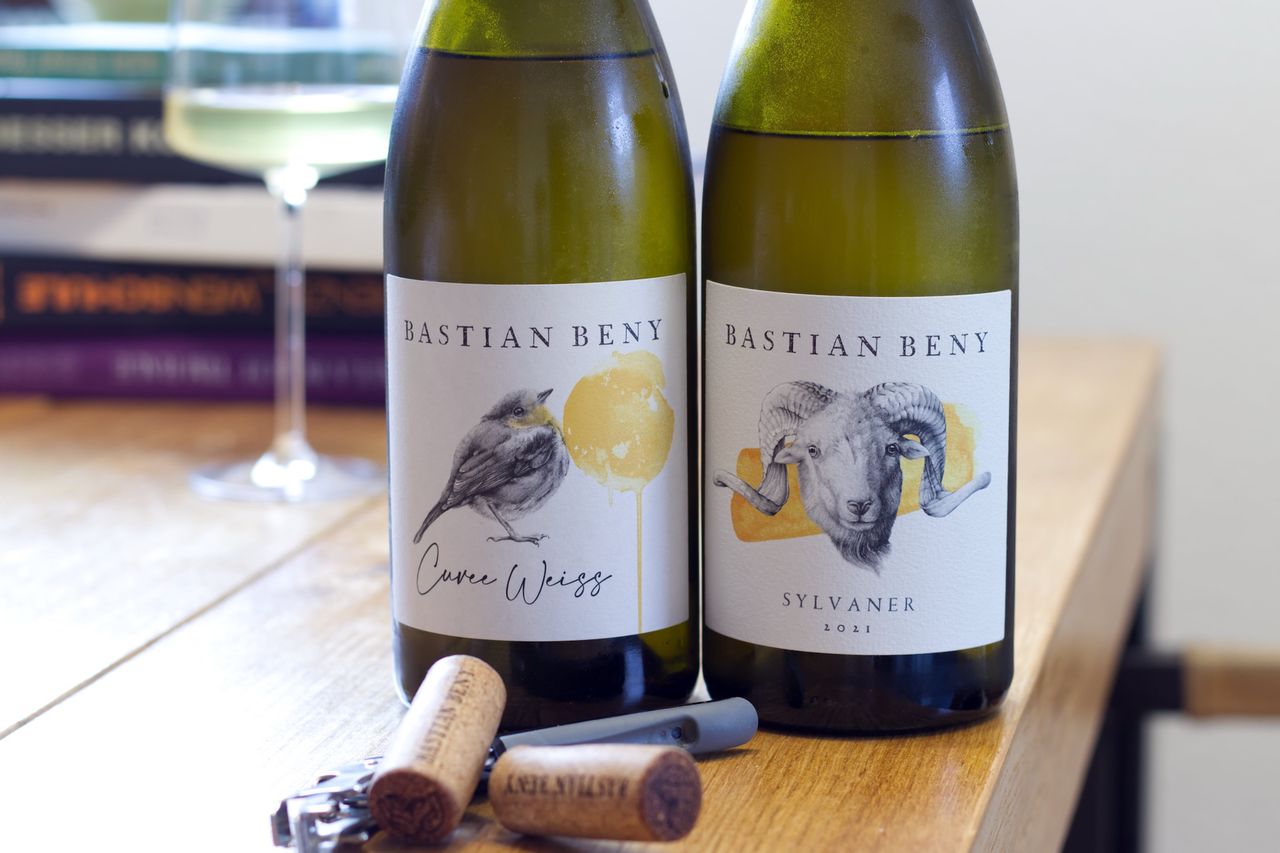Two Bottles Bastian Beny
We're drinking a bottle of Cuvée Weiss and a Sylvaner from Bastian Beny, both from 2021.

The bottles from Bastian Beny are the kind of wine that I come across somewhere on social media, think to myself that they look really chic, then see them again somewhere else, and then the bottles just have to be on the table. And there they are now. Bastian originally worked as a chef before joining the family winery in 2017. At that time, the focus was still on conventionally produced bulk wine and part-time work. Bastian began to change that, eliminating fertilizers, acquiring dwarf sheep for support, and developing the vineyards towards biodynamic management. 2023 was the first year with certification. At the same time, he studied in Geisenheim and gained experience working with various winemakers such as Eva Fricke, Klaus Peter Keller, and Wagner-Stempel. Two years after joining, in 2019, Bastian and his girlfriend Gianna harvested the first grapes for their own wines. That’s almost five years ago now. Today we’re trying two wines, a bottle of Cuvée Weiss, the entry-level wine, and a Sylvaner. Both are from 2021. The Cuvée Weiss is half Kerner, fermented on the skins for ten days. The rest is Riesling and Weissburgunder. In the current vintage of 2022, Müller-Thurgau is the main grape variety for this wine instead of Kerner. Neither are necessarily the most prestigious varieties, but the vineyards are there from bulk wine production. And anyway, in recent months and years here on the blog, we’ve had more than enough wines of both varieties that have totally excited me. After fermentation, the wine is aged on the lees for nine months in wood and stainless steel before being bottled with a little sulfur. The Sylvaner, harvested from over 40-year-old vines, matures for one and a half years under a layer of flor yeast in wooden barrels, protecting the wine from oxidation, something more commonly seen in Jura or Sherry and not necessarily with Sylvaner from Rheinhessen.
We start with the Cuvée. It smells a bit wild, a bit yellow, and a bit yeasty. And although we had Kerner in the glass not too long ago, I don’t want to stick my neck out and judge whether it smells particularly like Kerner or not. There’s Riesling and Weissburgunder in there too, after all. The wine drinks super juicy, almost lemonade-like, but at the back of the tongue, there’s also a good amount of texture. It’s fresh, uncomplicated, and actually just delicious.
The next day, the wine is creamier on the nose, and you can almost smell the texture that you felt on the tongue the night before. The first sip surprises with a now really crisp acidity. Somewhere between lemon and green apple, it drinks even faster than before. And with each sip, it brings more texture and herbal notes. The small remainder on the third evening seamlessly continues this trend. Once again, an example that those who don’t buy wines with Kerner, Trollinger, Müller-Thurgau, and Co in the bottle are missing out on quite a bit.
The initial contact with the Sylvaner, on the other hand, is challenging. It somehow smells unfinished right after pouring. There’s a lot more yeast in the nose, and almost nothing else behind it. But experience and this wine show that you can remedy this with a skillful movement of the hand. Swirl, swirl, swirl. Or just fill it into a carafe early enough. The yeast then disappears. The wine is then not so far from the Cuvée in the nose. A bit darker, more serious, somehow more adult. There are herbs, a bit of blackcurrant, and a very similar yellow fruit. If I hadn’t read that there was flor yeast involved here, I wouldn’t notice it at first. And even when drinking, the Sylvaner seems a bit reserved at first too. Already juicy, but not this kind of “I want the next sip” juiciness. It rather slowly pulls the saliva out of the cheek pockets. But with much more endurance. And the texture also extends much further over the tongue and then slowly transitions into a salty nuttiness, which probably originates from the flor yeast. It took a bit, but it ended the evening impressively.
And with a day of air, you could actually mistake it for Savagnin from the Jura with a fleeting whiff. Not one that’s not been topped up, but a slightly milder representative. Picking out individual aromas is almost impossible, this is more the sum than the parts. There are still the herbs, the freshness, and the salt. There is significantly more salt now from the lips to the middle of the tongue. The acidity is more austere than in the Cuvée, not so fruity, somehow more straightforward, with more structure and texture all around. A bit like biting into the core of an apple. Just salty. I’m considering ordering another bottle to find out how it tastes with some aging. You can’t ask anyone about that yet, this wine simply hasn’t been around long enough. And even with the small remainder on the third evening, it continues like this. Herbal tea on the nose, less tannin now, more grapefruit than lemon, and actually now very juicy. This is a truly great wine and one of the most interesting Sylvaners so far.